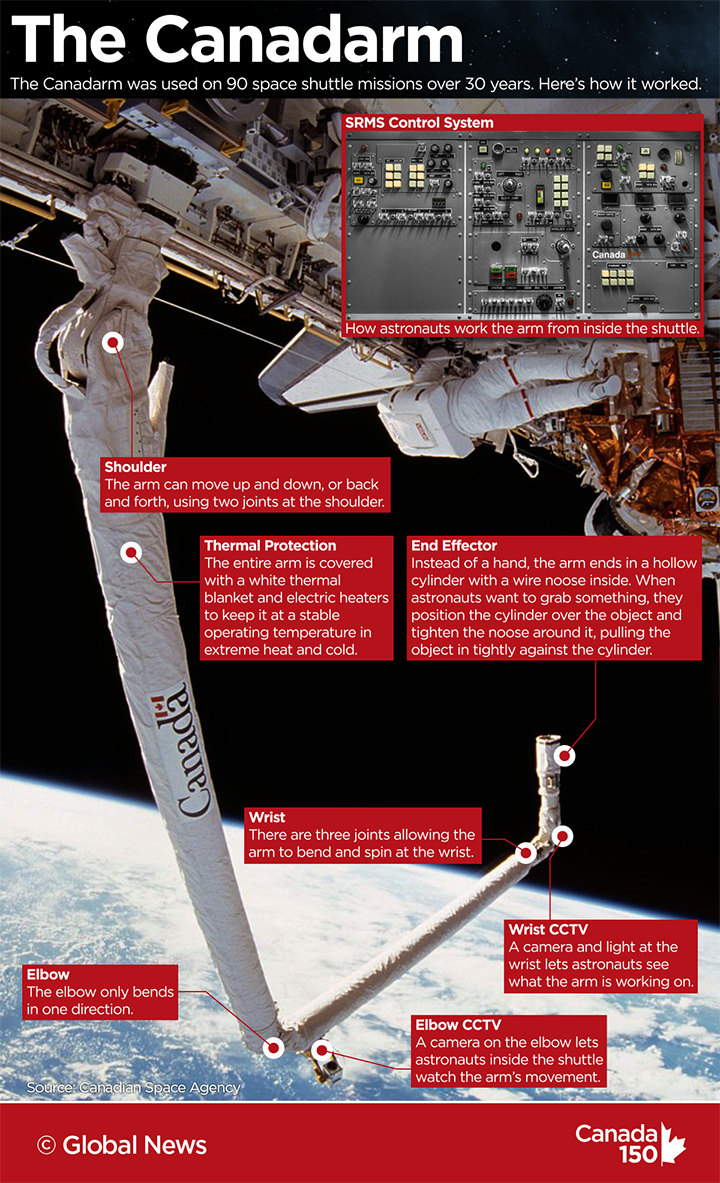Editor’s note: An earlier version of this story incorrectly stated that the Canadarm was retired in 2001, not 2011. We regret the error.

When designing a robotic arm for the space shuttle, Canadian engineers faced a number of problems. Chief among them: how do you design something that can never be tested?
NASA had strict specifications when it came to weight, dexterity, safety and reliability. The arm needed to be operated remotely and allow astronauts to move objects out of the orbiter’s cargo bay and into space.
The engineers decided on something like a giant crane, controlled by a joystick.
The arm was 15 metres long and weighed less than 480 kilograms, but could lift over 30,000 kilograms, according to the Canadian Space Agency’s website. In the weightlessness of space, it could lift up to 266,000 kilograms “using less energy than a teakettle.”
READ MORE: The changing face of Canada, from 150 years ago to today
Unfortunately for the engineers, the Canadarm couldn’t even lift itself up in Earth’s gravity. It had to be tested in a specially-designed room, as well as through computer simulations.
- ‘Shock and disbelief’ after Manitoba school trustee’s Indigenous comments
- Invasive strep: ‘Don’t wait’ to seek care, N.S. woman warns on long road to recovery
- ‘Super lice’ are becoming more resistant to chemical shampoos. What to use instead
- Canadian food banks are on the brink: ‘This is not a sustainable situation’
So engineers were understandably relieved when the arm successfully deployed on the Space Shuttle Columbia in 1981.
“Okay, the arm is out for the first time… working great… it’s a remarkable flying machine and it’s doing exactly as we hoped and expected,” said pilot Richard Truly, according to an account on the CSA website.
“Its remarkable performance produced a rush of relief and joy,” said Garry Lindberg, first project manager for the Canadarm. “We had done everything possible to make it work, but we had never been able to test it in a space environment. Seeing the arm deployed without a hitch showed that the eight years of hard work had paid off with a spectacular success.”
READ MORE: Memories and mementos from Canada’s 100th birthday
The Government of Canada invested $108 million in designing and building the first Canadarm, and NASA ordered four more after the first proved so useful. Canadarm flew on 90 missions between 1981 and 2011, helping with things like setting up the Hubble Telescope, retrieving a stranded communications satellite and building the space station.
The Canadarm was retired in 2011 when NASA ended the space shuttle program, though the bigger Canadarm 2 remains in space as part of the International Space Station.
Read more Canada 150 coverage.
In celebration of Canada’s 150th birthday, History channel has unveiled a slate of digital shorts, titled Thank You, Canada, reflecting our nation’s historical successes and milestones. They’ll be rolling out from now until Canada Day (July 1).
History and Global News are Corus Entertainment properties.





Comments